Barrier Films: SiOx Barrier Benefits
- Published: October 01, 2010, By By Marius Beune, Amcor Flexibles
Consumers are continuously changing their eating and purchasing behavior. A century ago, food was bought fresh and directly from the source — the farmer, butcher, and baker. Nothing was packaged, it was simply wrapped in paper. Today our daily food requirements have changed dramatically to match our lifestyle. We buy food in a supermarket, often some distance from our homes, and transport it.
Food packaging protects the integrity of the product and makes all of this possible. These days we can store food for months in and even out of the refrigerator, and when we decide to eat it, we want it to taste as fresh as the day it was produced.
An innovative technology provides an SiOx (silicon oxide) coating that offers the conditions for a high-barrier layer against moisture, gas, and aromas. In this way, food products can be kept fresh for a longer period.
Why Do We Need Barriers in Packaging Products?
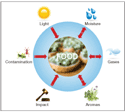
Barriers prevent interchanging actions between packed food products and their environment (see Figure 1). This can be anything from dust, contamination, light, mechanical impact, gas, and moisture to aromas. The food product itself also may influence its direct environment when it is spicy or contains essential oils or aggressive ingredients.
Packaging materials can provide these necessary barriers and protect and preserve our food, but all have their specific properties. Glass is transparent and is an excellent barrier material, but it's less good against light, and it breaks under high impact. Aluminium foil is a very good barrier against moisture, gases, contamination, and light, but it provides very little protection against mechanical impact and is very brittle.
Plastic films are very flexible and offer medium protection against moisture, gases, and aromas. However, consumers expect not only product protection from packaging, they want to see the food they buy; they want it to be safe to eat; they want it to stay fresh for a longer period; and above all, they want it to be tasty.
Furthermore, the consumer demands certain convenience properties of the packaging, i.e., it must be easy to transport and easy to open. All these requirements should be combined in one-and-the-same packaging.
How Do Barriers Function?
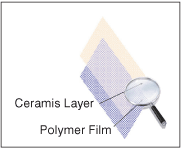
In cans and glass jars, the moisture and oxygen barriers are provided by the dense nature of the material. With thin plastic films, the situation is different. The molecular structure of polymer plastic films is in the form of chains, oriented like a grid. The more these chains are linked together, the better the barrier will be.
Although not visible to the human eye, there are still many tiny holes through which gas and moisture molecules can permeate. The finer the mazes of the grid, the better the barrier will be. An SiOx coating on top of this grid closes the tiny holes and gaps and will form an even, smooth, and almost impermeable layer (see Figure 2). In this way, it offers a high barrier against gases, aromas, and water vapor.
How Are SiOx Coatings Applied?

An SiOx coating can be applied to various types of substrates. One particular coating, Ceramis, comprises a thin inorganic layer of silicon oxide that has been evaporated in a vacuum environment to substrates like polyethylene terephthalate (PET), oriented polyamide (OPA) and biaxially oriented polypropylene (BOPP). The solid silicon oxide is heated by an electron beam and sublimates, then the vapor condensates, forming a very thin barrier layer on the film that is conveyed on a cooling roll (see Figure 3). The thickness of the crystal clear, thin layer is between 40 and 80 nanometers according to the application.
When used in packaging applications, it's necessary to convert the SiOx film to a laminate in order to protect the SiOx coating from mechanical damages during further processing. The lamination substrate enhances the moisture and oxygen barrier of the structure (see Figure 4 below).
Why Can't We See the SiOx Coating?

A silicon oxide coating is a slight modification of silicon dioxide, and that also is known as sand. Sand is the most important base material for glass manufacturing.
When silicon oxide is melted, it transforms from a crystalline to an amorphous state. In the amorphous state, it turns clear and transparent. When cooling down again, the silicon oxide remains in the amorphous state and stays clear.

When SiOx-coated films are produced, the silicon oxide is heated by the electron beam and evaporates as glass vapor. The condensate on the film forms a very thin “glass layer” that is approximately 1,000 times thinner than a human hair (see Figure 5). The silicon oxide, however, has been modified in such a way that the “glass layer” is somehow flexible and can withstand certain movements of the film.
Consumers appreciate being able to see the food product inside the packaging before they buy it. SiOx films can offer the highest clarity combined with the highest barrier, and there are even special grades with a built-in ultraviolet protection.
Continue to Page 2: SiOx in Packaging Films
SiOx in Packaging Films

SiOx films are always part of laminate structures. This varies from two- to four-ply films, depending on the application and pack style.
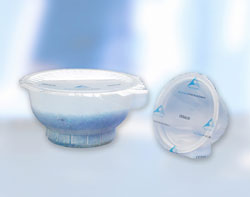
Modified Atmosphere Packaging (MAP) | MAP is a method whereby the packing of the food products takes place in an environment of protective gas. The inside head space of the pack is filled with an inert gas. This gas replaces the oxygen and enables an extension of the shelf life. One SiOx product line offers dedicated films for MAP (see Figure 6). Many kinds of food products can be packed this way, like bread, pizzas, cheese, and processed food.

Lidding Films for Retort Products | Many food products will be sterilized after they have been packed (see Figure 7). This process makes the food safe to preserve and to consume. This sterilization process, with temperatures of more than 120 deg C, exposes the packaging material to high thermal stress and pressure. The barrier layer must not be affected by stress, moisture, and/or temperature because the food product needs to be well protected. Barrier laminates containing ethylene vinyl alcohol (EVOH) instead of SiOx could be affected by the moisture uptake, the so-called “retort shock.” The risk of oxygen and moisture permeation through such a laminate is imminent for a period of 10-15 days before the barrier restores itself to a certain extent (see Figure 8).
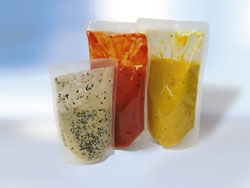
Stand-Up Pouches | Stand-up pouches are an innovative pack style for soups, sauces, and pastas and are a rapidly growing trend (see Figure 9). SiOx films for this pack style are suitable for both sterilized and nonsterilized applications. Inspired by the transparent high gas and moisture barrier, many food producers have replaced tin cans and glass jars with SiOx-based pouch materials.

Flow Packs | Flow packing is a method whereby the food products are forwarded to the pack station on a conveyor belt or tube. Simply explained: a flexible laminate is moved around the food products and heat-sealed in the longitudinal direction as well as on both ends. In this way, a cushion-shaped pack is created (see Figure 10). In order to keep the food product fresh, a high-barrier laminate is needed. SiOx films offer a dedicated solution.
Biodegradable PLA Barrier Films
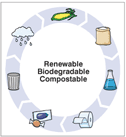
Biodegradable polylactic acid (PLA) films are finding ever more applications in the market. A combination of SiOx and PLA employs biodegradable thermoplastic polymer made from the annually renewable resource corn (see Figure 11).
SiOx-coated PLA films now are available with a high barrier against oxygen and water vapor (see Figure 12).
The SiOx coating provides the necessary barrier to use PLA films for shelf-stable food packaging (see Figure 13, below). Because the manufacturing of PLA barrier films is based on annually renewable resources, the biodegradable films do not have a negative impact on the environment after usage since the packaging is completely compostable.

Leading producers of packaging for the food, pharmaceutical, cosmetics, and technical markets are using SiOx with complete confidence based on a proven track record.
Supplier Info
- Amcor | www.amcor.com/ceramis
Circle 328 or visit www.freeproductinfo.net/pff

Marius Beune joined the Amcor Ceramis team in Switzerland in 2007. After studying mechanical engineering, his career developed in sales and marketing. He has extensive experience in the field of aluminium foils and plastic films for food and technical applications. In 2002, Beune was involved in the Europe-wide market launch of PLA films. He is responsible for sales of Ceramis-Films in Europe and Latin America and can be reached at +41 71 6777233; This email address is being protected from spambots. You need JavaScript enabled to view it..
The views and opinions expressed in Technical Reports are those of the author(s), not those of the editors of PFFC. Please address comments to the author(s).





